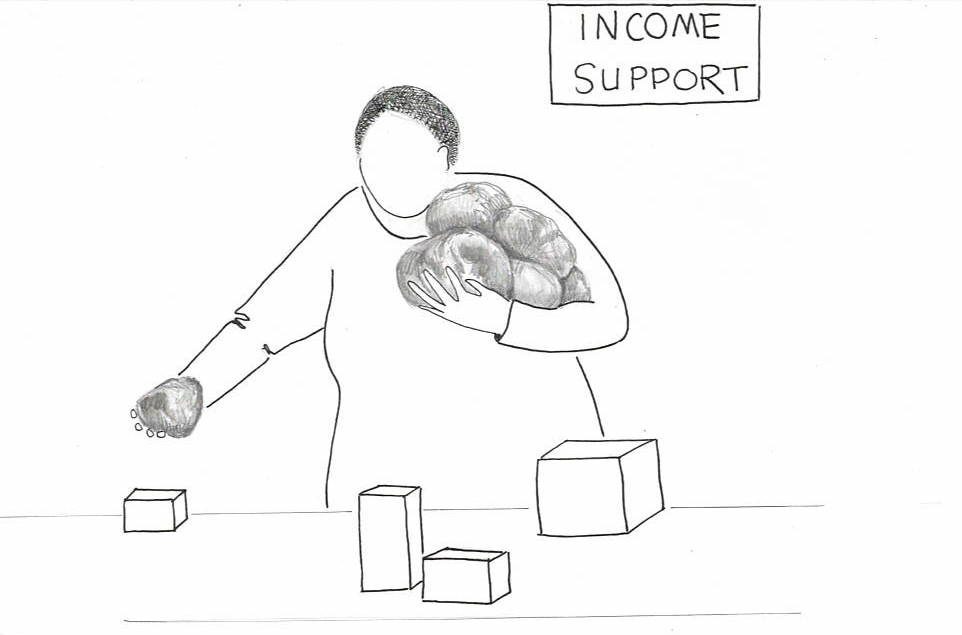The set & props at work during the performance

To illustrate some of the ways the set and props work, let’s look at We Need to Talk! Often performed in classroom or community settings, the set design is necessarily simple and adaptable. Here’s one version of the set up: The ‘stage’ is set with three tables marked ‘Income Support,’ ‘Housing,’ and ‘Food Bank.’ There are several small boxes on each table and empty chairs on the audience’s side of the tables but facing away from the audience. There is also a ‘Waiting Room’ sign accompanied by a row of chairs and, close to the audience, a trolley full of paper-mâché rocks.
The play opens with the performers introducing their characters. They describe their characters’ strengths, things they’re proud of, and some of the burdens their characters ‘carry’: histories of violence, hidden disabilities, care responsibilities, and so on. As they speak, they pick up paper-mâché rocks from the trolley. Each character carries their armload of rocks throughout the play as they repeatedly approach the different agencies in their efforts to access social services.“I liked that there was such a diverse group of women and experiences represented. I also liked that when sitting in the crowd as a social work student I felt like I could be in that seat in the future either helping or hindering.” — Audience member, We Need to Talk!
This opening scene imprints the rocks with meaning. As the play proceeds and the audience listens to the words of the story, the rocks act as a sustained visual reminder of the contexts of the women’s lives. Though physically lightweight, the armloads of rocks are cumbersome. They are difficult to balance and hinder the performer-advocates’ movements. This physical struggle to carry and balance the rocks as the performers’ characters travel from agency to agency becomes a way of making visible the labour of carrying burdens that can often go unseen by social service providers. It’s obvious from the play’s actual dialogue that interactions with service providers are difficult for the women; the symbolically imprinted rocks allow the audience to better understand just how difficult (and exasperating, and unjust). We can imagine more accurately the effects of the providers’ words and actions because we are able to ‘see’ what the women are really carrying with them.“The rocks really give you a visual of how much you’re struggling, how they are hard to balance.” — Audience member, We Need to Talk!
In addition to enhancing audience understanding, from a dramaturgical (or storytelling) perspective, the rocks also allow us to compress time. The play’s characters don’t need to have entire scenes about how they fled domestic violence with a child under their arm, or how they were diagnosed with a serious illness. They can just mention those things, pick up the rocks, and that whole past is carried in the play’s unfolding story about the challenges of accessing social services.

The impact of the rocks themselves is further amplified by the rest of the play’s set. As the performers approach each agency and attempt to fit their rocks into the available boxes they face and speak to the empty chair that accompanies each agency table. Since We Need to Talk! was performed for audiences largely made up of current or future social service providers, audience members had an opportunity to imagine themselves occupying the chair. This indirect confrontation with the audience is made overt in the play’s final scene when the women look at each other, drop all their rocks on the agency tables, drop out of character, and say directly to the audience: “This isn’t working. We need to talk!”
Performing without a set or props would be tall order even for professional actors. For non-professional community-based performer-advocates whose theatre training is limited to a short workshop series, performing without a set and props would be particularly daunting. During the performance, the set and props support the performers in communicating an action-based and visual story. Now let’s look behind the scenes at some of the ways that the set and props support the performers during the workshops and throughout the devising process.

